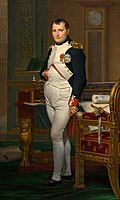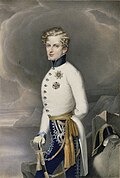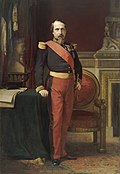| Claimant | Portrait | Birth | Marriages | Death |
|---|
Napoleon I*
1814–1815
1815–1821 |  | 15 August 1769, Ajaccio
Son of Carlo Buonaparte
and Letizia Ramolino | Joséphine de Beauharnais
9 March 1796
No children
Marie Louise, Duchess of Parma
11 March 1810
1 child | 5 May 1821
Longwood, Saint Helena
Aged 51 |
Napoleon II*
1811–1832 |  | 20 March 1811, Paris
Son of Napoleon I
and Marie Louise of Austria | Never married | 22 July 1832
Vienna
Aged 21 |
Joseph Bonaparte
(Joseph I)
1832–1844 |  | 7 January 1768, Corte
Son of Carlo Buonaparte
and Letizia Ramolino | Julie Clary
1 August 1794
2 children | 28 July 1844
Florence
Aged 76 |
Louis Bonaparte
(Louis I)
1844–1846 |  | 2 September 1778, Ajaccio
Son of Carlo Buonaparte
and Letizia Ramolino | Hortense de Beauharnais
4 January 1802
3 children | 25 July 1846
Livorno
Aged 67 |
Napoleon III*
1846–1873
President of France (1848–1852)
Emperor of the French (1852–1870) |  | 20 April 1808, Paris
Son of Louis Bonaparte
and Hortense de Beauharnais | Eugénie de Montijo
30 January 1853
1 child | 9 January 1873
Chislehurst
Aged 64 |
Napoléon, Prince Imperial
(Napoleon IV)
1873–1879 |  | 16 March 1856, Paris
Son of Napoleon III
and Eugénie de Montijo | Never married | 1 June 1879
Zulu Kingdom
Aged 23 |
Prince Napoléon-Jérôme Bonaparte
(Napoleon V)
1879–1891
(disputed) |  | 9 September 1822, Trieste
Son of Jérôme, King of Westphalia
and Catharina of Württemberg | Princess Maria Clotilde of Savoy
30 January 1859
3 children | 17 March 1891
Rome
Aged 68 |
Victor, Prince Napoléon
(Napoleon V)
1879–1926
(disputed until 1891) |  | 18 July 1862, Palais-Royal
Son of Prince Napoléon-Jérôme Bonaparte
and Princess Maria Clotilde of Savoy | Princess Clémentine of Belgium
10/14 November 1910
2 children | 3 May 1926
Brussels
Aged 63 |
Louis, Prince Napoléon
(Napoleon VI)
1926–1997 |  | 23 January 1914, Brussels
Son of Victor, Prince Napoléon
and Princess Clémentine of Belgium | Alix de Foresta
16 August 1949
4 children | 3 May 1997
Prangins
Aged 83 |
Charles, Prince Napoléon
(Napoleon VII)
1997–present
(disputed) |  | 19 October 1950, Boulogne-Billancourt
Son of Louis, Prince Napoléon
and Alix, Princess Napoléon | Princess Béatrice of Bourbon-Two Sicilies
19 December 1978
2 children
Jeanne-Françoise Valliccioni
28 September 1996
2 children (1 adopted) | |
Jean-Christophe, Prince Napoléon
(Heir apparent)
1997–present
(disputed) |  | 11 July 1986, Saint-Raphaël, Var
Son of Charles, Prince Napoléon
and Princess Béatrice of Bourbon-Two Sicilies | Countess Olympia von und zu Arco-Zinneberg
17 October 2019
1 child | |
|














